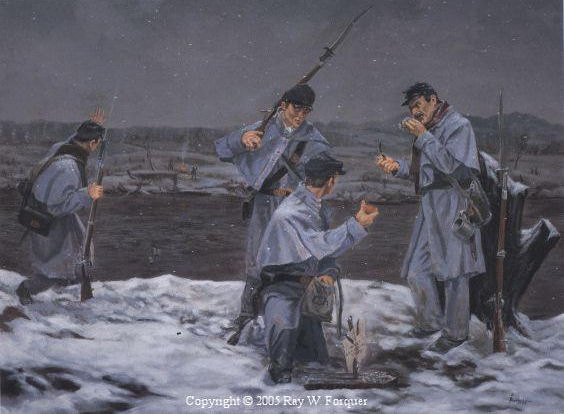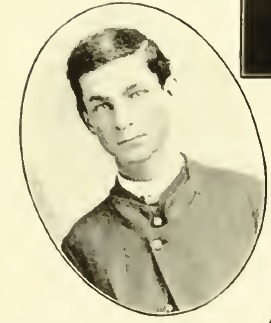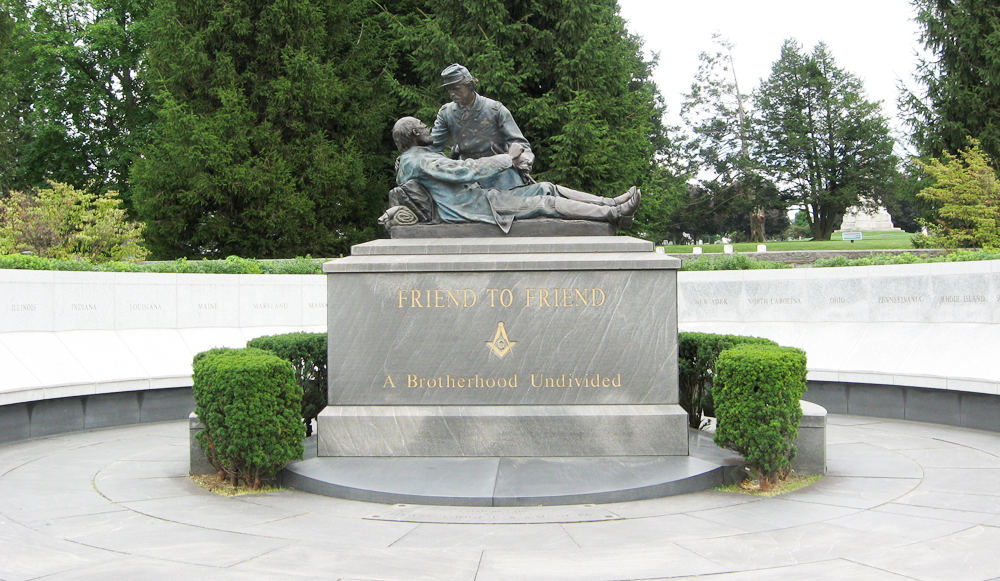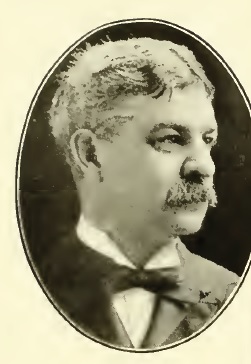Christmas on the Rappahannock

About twenty years ago my parents bought me a Civil War painting by Ray W. Forquer. The painting, “Christmas on the Rappahannock,” has always been one of my favorites. It’s not the artistry that I love so much, but the story that painting is based on. While much of the Civil War art that is out there revolves around the famous meetings of Lee and Jackson, or the heroic deeds on men on the field of battle, “Christmas on the Rappahannock” tells a much different story. It’s the story of a handful of soldiers, both blue and gray, away from their loved ones at Christmas. Although their ideals and a river divide them, these men find a way to put their differences aside for a few hours on Christmas Day, 1862.
The storyteller is John R. Paxton. Paxton was 18 years old in 1862 and was a private in Company G of the 140th Pennsylvania Infantry. His unit had been formed during the “Emergency of 1862,” as the rise of Robert E. Lee turned the Civil War on its ear. The ten companies that comprised the 140th Pennsylvanian were recruited in Western Pennsylvania from Greene, Mercer, Beaver, and Washington Counties. Washington County men made up the core of the unit, as five of the companies came from said county. Company G was one of those Washington County companies. A large number of Company G’s men came from the faculty, alumni, and student population of Jefferson College, in Canonsburg, Pennsylvania.* The “Canonsburg Brown Infantry,” as they were nicknamed, carried 103 men off to war. The original company commander was John Fraser. Fraser was a professor of Mathematics at the college. He took advantage of his final lecture in 1862 to call on the patriotic men in his class to go off to war with him in defense of the Union. John Paxton was one of those students. A rising senior, Paxton put his studies on hold to go off to war with his professor. Also joining Company G with John were his brothers Wilson and Thomas.
The war would carry John and his unit to some of the most hellacious points on Civil War battlefields. At Chancellorsville, Company G helped to extract wounded Federal soldiers from the Chancellor House, as it burned on May 3, 1863.
At Gettysburg the unit as a whole lost 241 of the 589 men engaged on Stony Hill, just west of the Wheatfield. Wilson Paxton was wounded there and spent the next twenty months of the war as a prisoner.
At Spotsylvania, the 140th was one of the first over-the-top on May 12th, as they helped to break open the Mule Shoe. It was at Spotsylvania that Thomas Paxton was killed in action, fighting near the Po River on May 9th.

John survived the war unscathed. By the time the unit returned to Western Pennsylvania in 1865, John was a captain, and in command of Company G. Of course this was all in the future on Christmas Day 1862.**
The 140th Pennsylvania arrived at the front with the Army of the Potomac on December 20, 1862, just days after the stinging defeat at Fredericksburg. Nicknamed the “Walking Artillery,” because of the heavy Vincennes Rifles they had been issued, the regiment was assigned to the 3rd Brigade, 1st Division, of the 2nd Corps. On Christmas Day the men of the 140th Pennsylvania were rotated to the front for picket duty. Many of the green Keystone State men found themselves away from home on Christmas for the first time. Standing on the cold banks of the Rappahannock River, some of the men started a conversation with the enemy pickets, men of William Barksdale’s Mississippi brigade. I will allow John Paxton to tell you the story of what transpired that Christmas Day, in his own words.
Gentlemen, the chair of the Professor of Mathematics is vacant in this college; permit me to introduce to you Captain [John] Fraser.” Rah! rah! rah! and away we went and enlisted—to go to Richmond. It took us three years to get there. No wonder; there were so many Longstreets to make our way through ; so many Hills to climb ; so many Stonewalls to batter down; so many Picketts to clear out of the way. It was as hard a road to travel as the steep and stony one to heaven…
I started for Richmond in July, 1862, a lad eighteen years old, a junior in college, and chafing to be at it,—to double quick it after John Brown’s soul, which, since it did not require a knapsack or three days’ rations or a canteen or a halt during the night for sleep, was always marching on.
On the night before Christmas, 1862, I was a dejected young patriot, wishing I hadn’t done it, shivering in the open weather a mile back of the Rappahannock, on the reserve picket and exposed to a wet snowstorm. There was not a stick of wood within five miles of us; all cut down, down, even the roots of trees, and burned up. We lay down on our rubber blankets, pulled our woolen blankets over us, spooned it as close as we could get to steal warmth from our comrades and tried not to cry.
Next morning the snow lay heavy and deep, and the men, when I wakened and looked about me, reminded me of a church graveyard in winter. “Fall in for picket duty. There, come, Moore, McMeaus, Paxton, Perrine, Pollock, fall in.” We fell in, of course. No breakfast; chilled to the marrow; snow a foot deep. We tightened our belts on our empty stomachs, seized our rifles and marched to the river to take our six hours on duty.
It was Christmas Day, 1862. “And so this is war,” my old me said to himself while he paced in the snow his two hours on the river’s brink. “And I am out here to shoot that lean, lank, coughing- cadaverous-looking butternut fellow over the river. So this is war; this is being a soldier; this is the genuine article; this is H. Greeley’s ‘On to Richmond.’ Well, I wish he were here in my place, running to keep warm, pounding his arms and breast to make the chilled blood circulate. So this is war, tramping up and down this river my fifty yards with wet feet, empty stomach, swollen nose.”
Alas, when lying under the trees in the college campus last June, war meant to me martial music, gorgeous brigadiers in blue and gold, tall young men in line, shining in brass. War meant to me tumultuous memories of Bunker Hill, Caesar’s Tenth Legion, the charge of the Six Hundred,—anything but this. Pshaw, I wish I were home. Let me see. Home? God’s country. A tear? Yes, it is a tear. What are they doing at home? This is Christmas Day. Home? Well, stockings on the wall, candy, turkey, fun, merry Christmas, and the face of the girl I left behind. Another tear? Yes, I couldn’t help it. I was only eighteen, and there was such a contrast between Christmas, 1862, on the Rappahannock and other Christmases. Yes, there was a girl, too,—such sweet eyes, such long lashes, such a low tender voice.
“Come, move quicker. Who goes there?” Shift the rifle from- one aching shoulder to the other.
“Hello, Johnny, what are you up to?” The river was narrow, but deep and swift. It was a wet cold, not a freezing cold. There was no ice, too swift for that.
“Hello, Johnny, what you coughing so for?”
“Yank, with no overcoat, shoes full of holes, nothing to eat but parched corn and tobacco, and with this derned Yankee snow a foot deep, there’s nothin’ left, nothin’ but to get up a cough by way of protestin’ against this infernal ill treatment of the body. We uns, Yank, all have a cough over here, and there’s no sayin’ which will run us to hole first, the cough or your bullets.”
The snow still fell, the keen wind, raw and fierce, cut to the bone. It was God’s worst weather, in God’s forlornest, bleakest spot of ground, that Christmas Day of ’62 on the Rappahannock, a half-mile below the town of Fredericksburg. But come, pick up your prostrate pluck, you shivering private. Surely there is enough dampness around without your adding to it your tears.
“Let’s laugh, boys.”
“Hello, Johnny.”
“Hello, yourself, Yank.”
“Merry Christmas, Johnny.”
“Same to you, Yank.”
“Say, Johnny, got anything to trade?”
“Parched corn and tobacco,—the size of our Christmas, Yank.”
“All right; you shall have some of our coffee and sugar and pork. Boys, find the boats.”
Such boats ! I see the children sailing them on the small lakes in our Central Park. Some Yankee, desperately hungry for tobacco, invented them for trading with the Johnnies. They were hid away under the banks of the river for successive relays of pickets.
We got out the boats. An old handkerchief answered for a sail. We loaded them with coffee, sugar, pork, and set the sail and watched them slowly creep to the other shore. And the Johnnies?
To see them crowd the bank and push and scramble to be first to seize the boats, going into the water and stretching out their long arms. Then, when they pulled the boats ashore, and stood in a group over the cargo, and to hear their exclamations, “Hurrah for hog.” “Say, that’s not roasted rye, but genuine coffee. Smell it, you’uns.” “And sugar, too!”
Then they divided the consignment. They laughed and shouted, “Reckon you’uns been good to we’uns this Christmas Day, Yanks.” Then they put parched corn, tobacco, ripe persimmons, into the boats and sent them back to us. And we chewed the parched corn, smoked real Virginia leaf, ate persimmons, which if they weren’t very filling at least contracted our stomachs to the size of our Christmas dinner.
And so the day passed. We shouted, “Merry Christmas, Johnny.” They shouted, “Same to you, Yank.” And we forgot the biting wind, the chilling cold ; we forgot those men over there were our enemies, whom it might be our duty to shoot before evening. We had bridged the river, spanned the bloody chasm. We were brothers, not foes, waving salutations of good-will in the name of the Babe of Bethlehem, on Christmas Day in ’62. At the very front of the opposing armies, the Christ Child struck a truce for us, broke down the wall of partition, became our peace. We exchanged gifts. We shouted greetings back and forth. We kept Christmas and our hearts were lighter for it, and our shivering bodies were not quite so cold.
*Canonsburg is the hometown of singer Perry Como. In 1865 Jefferson College merged with Washington College, in Washington, PA. It was not until 1871 though, that the two campuses were united. Today the college is called Washington & Jefferson.
Also from Canonsburg was Dr. Jonathan Letterman the “Father of Battlefield Medicine.” Letterman is a graduate of Jefferson College. Another Jefferson College Civil War connection is Col. James Beaver. Beaver commanded the sister regiment of the 140th, the 148th Pennsylvania. The Jefferson College alum survived the war, became governor of Pennsylvania, and Beaver Stadium at Penn State is named for him.
Jefferson College also produced one recipient of the Medal of Honor. William H. H. Bingham, better known as Henry Bingham, was bestowed the medal for actions at the Battle of the Wilderness on May 6, 1864. Bingham was an original member of Company G of the 140th Pennsylvania, but had been on detached staff duty for much of the war. Most buffs know him from the Friend to Friend Masonic Memorial at Gettysburg.

**John Paxton returned to Jefferson College and graduated in 1866. He went onto attend both Western Theological Seminary and Princeton Theological Seminary. In 1874 he was the minister of the Pine Street Church, of Harrisburg, Pennsylvania. (Ironically, the men of the 140th Pennsylvania worshiped in this same church on September 8, 1862. The unit had been stationed in the area.) He went onto become the minister of churches in Washington D.C. and New York City. He later penned a book Sword and Gown.

Excellent piece. I have been collecting true stories, graphics and information about Christmas during the Civil War for several years now, so it is a topic of some interest to me.
Thanks Christopher. I am glad you enjoyed. All the best in the new year.
Reblogged this on The Late Unpleasantness: A Civil War Blog and commented:
Christmas during the Civil War has been a particular interest of mine for several years now; here is an excellent account of one incident by Kris White.
Those Barksdale boys were fine gentlemen, to be sure.
Indeed Mike. I love reading and writing about them.